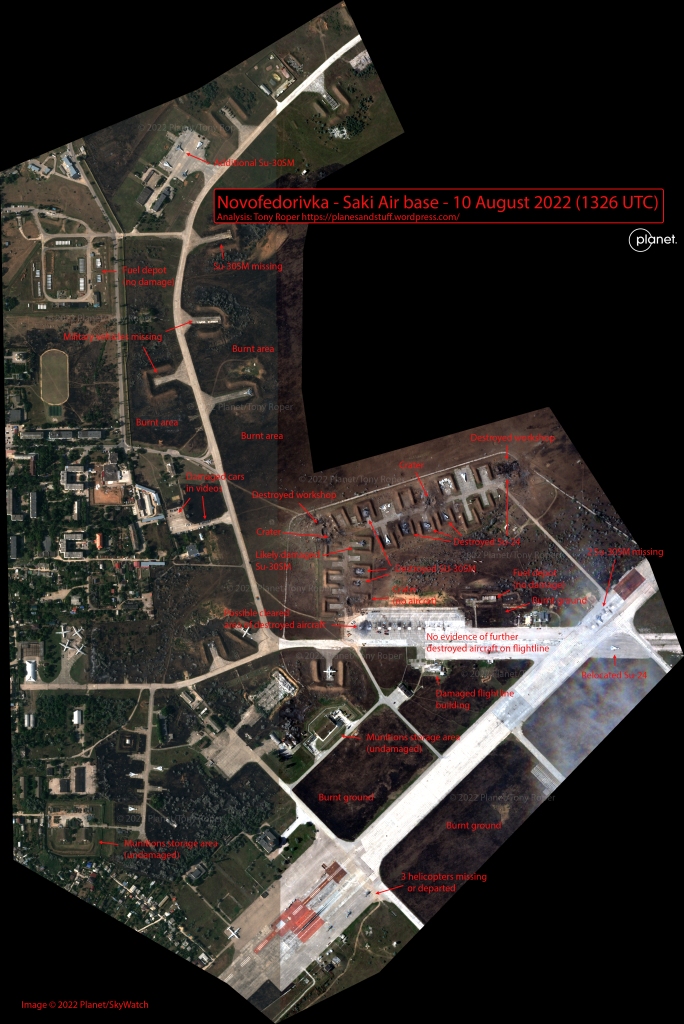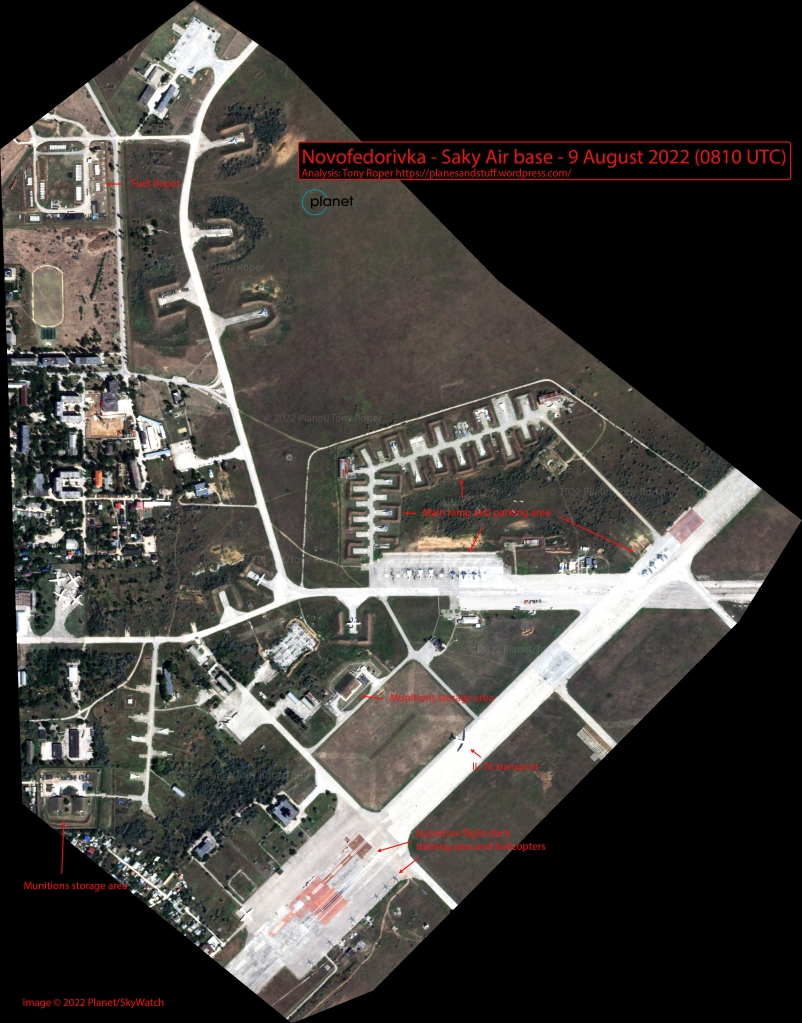Yesterday – or rather, in the early hours of today – I posted my last blog, Novofedorivka – Saki Air base attack satellite imagery – The aftermath.
In that blog I made a typo. For every word where I meant to say Su-24, I said Su-23. This included in the satellite imagery labelling. So how could this possibly happen as I knew fully that they were Su-24s? I’d called them this correctly in the blog before that and regardless – I know what a Su-24 is.
To add salt to the wound of the error, on my desk next to me at the time of doing the analysis, I had the excellent books by Yefim Gordon & D Komissarov Sukhoi Su-24 and Sukhoi Su-27 & 30/33/34/35. They were still on my desk in the morning when I got up. I’d had the idea on going into a little detail about the aircraft themselves, but changed my mind.

Looking back at the creation of the blog, I’m pretty sure I know what happened. When I started working on the imagery, when I typed in the first Su-24 label, I inadvertently typed Su-23. This could have been in error by hitting the 3 key instead of the 4, or by just stupidly typing it incorrectly.
From there, the rest is history. I copy/pasted the label for the others in the imagery, and this is where the brain takes over. I subconsciously took in Su-23 as being correct – regardless of knowing what they were, and having pointers near me to correct the mistake (including checking back on the other imagery and blog looking for changes).
Moreover, when it came to proof reading the whole thing, it still slipped through the net again. I even found other mistakes that I rectified.
In other words I totally believed what I was typing and had typed was correct, even though subconsciously I knew it was wrong. And I let it pass – I was seeing what I wanted to see
In my daytime Air Traffic Control world we use the well known term confirmation bias for this.
What is interesting about the whole thing is that just two hours before, in a busy radar session, I was calling a couple of aircraft by the wrong callsign. This is extremely common for us, and for pilots too.
To explain. We have radar screens with data-blocks that show the aircraft callsign, altitude/level, selected level in the flight management system on the aircraft (via ADS-B) and the exit code from UK airspace or last two letters of the destination airfield. We have plenty of other things available to us via Mode-S, but these are selectable.
We also have electronic flight progress strips (eFPS) which has plenty more info on, but the callsign is the obvious one and what I want to look at here.
I can’t remember the exact callsigns, but take an example of EZY12QC – “Easy one two quebec charlie“. I called this one “Easy one two quebec golf” on its first contact, and despite having a eFPS and radar that i was fully interacting with, I continued to do so. It didn’t matter what was in front of me, it was “quebec golf”, not “quebec charlie”. There was at least another flight like that. All was safe as it was checked by the aircrew that the instructions were for them, but it adds extra workload and time to radio transmissions and getting the traffic moving.
An example of aircrew error is taking the wrong calls for other flights with similar callsigns – normally with the same airline, though inter-airline errors do occur. On one occasion, a flight I was working kept taking the call of another that was with the same airline. Eventually, after the fourth or fifth time, he apologised and said he’d been doing that flight the day before and couldn’t get it out of his head – despite coming from Spain and using the correct callsign up until then.
In ATC we use a combination of long term memory, and short term memory. The long term stuff is for things like procedures, sector frequencies etc. Airline callsigns come into this too – their actual airline callsign such as “Easy” for EasyJet, “Speedbird” for British Airways.
The short term stuff is things like co-ordinated agreements with other sectors, the actual traffic picture, flights on frequency etc.
Short term stuff we remove from our brains, once we have no use for it, but we keep the other stuff forever. I still remember things from RAF Lyneham when I was there in 1989!
And, of course, this isn’t an aviation thing. It is present in everything humans do in their lives.
So, how does this affect analysing imagery etc.?
With the last blog, it was probably a combination of being up since 7am, doing an afternoon shift finishing at 2200 UK time that included confirmation bias in the last hour – and then an hours drive home. In other words, a long, tiring day with a fuddled up brain already in place.
Going back to saying that we see what we want to see – analysing imagery has plenty of this.
Not everything of course, but occasionally it creeps in. And it happens to everyone.
I’ll take the Saki attack “aftermath” as a prime example of this as I think there’s several places this has happened. And I’m just going to say this now – this is not a direct dig at anyone in particular.
In fact, I’ll start with one of mine – or a possible one. I’ve been watching Saki since 2014 so know it pretty well I think. I also have access to some fantastic data on the base.
The two buildings destroyed at the revetments are known “workshops” used by the Russians for quick repairs to aircraft. Often this has entailed taking parts from one aircraft to put onto another to keep the fleet “airworthy”. This is likely why there was a Su-24 at the eastern building. Parts are stored in one of the revetments west of the building.
The two concrete parking areas also targeted were for vehicles, equipment and spare parts – often kept in boxes or crates. One has been referenced as a building in some analysis and on social media. This is completely wrong. You only have to look back through Google Earth history to see that often there are Su-24s parked there. But people are seeing what they want to see – and to be honest, being a little lazy and not checking themselves. It doesn’t take much to go back through GE history.
I have all this information stored in my head as long term memory and that is what I believe these areas are used for. At some stage over the last few months, and in particular over the last few days, these buildings and parking areas have become weapons storage areas according to reports and social media. Where this came from I have no idea, but certainly, since the attack they have been known as “ammo storage buildings”.
Likely, the main reason for this is because the number of boxes and crates has increased since the beginning of the war – and they’re green. My confirmation bias says these are all sorts of equipment, whereas others say they are ammo boxes because this is what they’ve read/been told; and their confirmation bias won’t say otherwise. Ammo boxes are being seen because they are green – and well, so are ammo boxes.
One of the concrete areas has white torpedo like objects. These are Su-24 3,000 litre external fuel tanks that they carry on the inner pylons, under the wings. In the aftermath imagery you can see they have been shifted by the power of the nearby explosion. These have been referenced to missiles in storage. They’re not.
In reality, we don’t actually know what was in these green boxes and crates. Logic tells me it isn’t all munitions as they have hardened areas specifically for this. But, the Russian forces do have open munitions storage areas located at bases all over the country so who is to say? More than likely, it will be a mix of things.
The real confirmation bias from this incident comes it at the main apron. The Planet imagery I provided for the morning before the attack showed three Su-24’s and three Su-30’s parked on the main flight line.
There are a number of things to note – referencing the first image below. Firstly, the aircraft follow white taxiway lines to a white square to stop and shut down. These squares are clearly visible where aircraft aren’t parked.
Secondly, next to each parking spot there is equipment used with the aircraft. Starter generators, wheel chocks, ladders and other things needed for the aircraft. These can be seen in between the parked aircraft in the imagery.
The last thing to note is that there isn’t an aircraft parked on the far west spot – this is the spot that in the post attack imagery there is supposedly a destroyed Su-24. As there’s no wreckage present, this can’t be confirmed 100%, but photos and video have been produced that do show a destroyed Su-24. Actually, in the post attack imagery the burnt area centres on the equipment between the parking spots.

Looking at the second image below you can clearly see all the equipment still in place. But many saw these as destroyed aircraft – and Hey, Presto! six more aircraft that are actually over to the east of the base have been destroyed!
Total confirmation bias – you are seeing what you want to see. Because we all want to see Russia fail (well not everyone, obviously).

And yet all the clues are there. At the probable destroyed Su-24 area, there’s a completely burnt out patch covering the parking squares – yet for the “other six” there isn’t. The obvious equipment – seen in imagery just 24 hours before – is ignored and declared as wrecks.
Whilst the aircraft that were on the flightline probably didn’t escape some damage, from confirmation bias we have claims that the whole fleet of aircraft were totally destroyed – and whilst it was a very successful attack – it wasn’t as successful as is claimed.
This leads to misinformation – and what I call ” Bad OSINT”.


